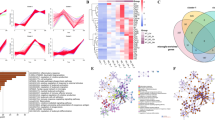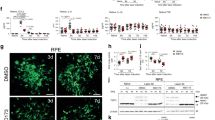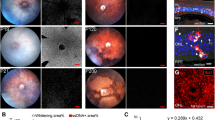Abstract
The innate immune system is activated in a number of degenerative and inflammatory retinal disorders such as age-related macular degeneration (AMD). Retinal microglia, choroidal macrophages, and recruited monocytes, collectively termed 'retinal mononuclear phagocytes', are critical determinants of ocular disease outcome. Many publications have described the presence of these cells in mouse models for retinal disease; however, only limited aspects of their behavior have been uncovered, and these have only been uncovered using a single detection method. The workflow presented here describes a comprehensive analysis strategy that allows characterization of retinal mononuclear phagocytes in vivo and in situ. We present standardized working steps for scanning laser ophthalmoscopy of microglia from MacGreen reporter mice (mice expressing the macrophage colony-stimulating factor receptor GFP transgene throughout the mononuclear phagocyte system), quantitative analysis of Iba1-stained retinal sections and flat mounts, CD11b-based retinal flow cytometry, and qRT–PCR analysis of key microglia markers. The protocol can be completed within 3 d, and we present data from retinas treated with laser-induced choroidal neovascularization (CNV), bright white-light exposure, and Fam161a-associated inherited retinal degeneration. The assays can be applied to any of the existing mouse models for retinal disorders and may be valuable for documenting immune responses in studies for immunomodulatory therapies.
This is a preview of subscription content, access via your institution
Access options
Access Nature and 54 other Nature Portfolio journals
Get Nature+, our best-value online-access subscription
$29.99 / 30 days
cancel any time
Subscribe to this journal
Receive 12 print issues and online access
$259.00 per year
only $21.58 per issue
Buy this article
- Purchase on Springer Link
- Instant access to full article PDF
Prices may be subject to local taxes which are calculated during checkout






Similar content being viewed by others
References
Reichenbach, A. & Bringmann, A. New functions of Muller cells. Glia 61, 651–678 (2013).
Vecino, E., Rodriguez, F.D., Ruzafa, N., Pereiro, X. & Sharma, S.C. Glia-neuron interactions in the mammalian retina. Prog. Retin. Eye Res. 51, 1–40 (2016).
Thanos, S., Moore, S. & Hong, Y. Retinal microglia. Prog. Retin. Eye Res. 15, 331–361 (1996).
Hume, D.A., Perry, V.H. & Gordon, S. Immunohistochemical localization of a macrophage-specific antigen in developing mouse retina: phagocytosis of dying neurons and differentiation of microglial cells to form a regular array in the plexiform layers. J. Cell Biol. 97, 253–257 (1983).
Liang, K.J. et al. Regulation of dynamic behavior of retinal microglia by CX3CR1 signaling. Invest. Ophthalmol. Vis. Sci. 50, 4444–4451 (2009).
Lee, J.E., Liang, K.J., Fariss, R.N. & Wong, W.T. Ex vivo dynamic imaging of retinal microglia using time-lapse confocal microscopy. Invest. Ophthalmol. Vis. Sci. 49, 4169–4176 (2008).
Karlstetter, M. et al. Retinal microglia: just bystander or target for therapy? Prog. Retin. Eye Res. 45, 30–57 (2015).
Madeira, M.H., Boia, R., Santos, P.F., Ambrosio, A.F. & Santiago, A.R. Contribution of microglia-mediated neuroinflammation to retinal degenerative diseases. Mediators Inflamm. 2015, 673090 (2015).
Zabel, M.K. et al. Microglial phagocytosis and activation underlying photoreceptor degeneration is regulated by CX3CL1-CX3CR1 signaling in a mouse model of retinitis pigmentosa. Glia 64, 1479–1491 (2016).
Zhao, L. et al. Microglial phagocytosis of living photoreceptors contributes to inherited retinal degeneration. EMBO Mol. Med. 7, 1179–1197 (2015).
Dannhausen, K. et al. Acid sphingomyelinase (aSMase) deficiency leads to abnormal microglia behavior and disturbed retinal function. Biochem. Biophys. Res. Commun. 464, 434–440 (2015).
Combadiere, C. et al. CX3CR1-dependent subretinal microglia cell accumulation is associated with cardinal features of age-related macular degeneration. J. Clin. Invest. 117, 2920–2928 (2007).
Xu, H., Chen, M., Mayer, E.J., Forrester, J.V. & Dick, A.D. Turnover of resident retinal microglia in the normal adult mouse. Glia 55, 1189–1198 (2007).
Sennlaub, F. et al. CCR2(+) monocytes infiltrate atrophic lesions in age-related macular disease and mediate photoreceptor degeneration in experimental subretinal inflammation in Cx3cr1 deficient mice. EMBO Mol. Med. 5, 1775–1793 (2013).
Luckoff, A. et al. Interferon-beta signaling in retinal mononuclear phagocytes attenuates pathological neovascularization. EMBO Mol. Med. 8, 670–678 (2016).
O'Koren, E.G., Mathew, R. & Saban, D.R. Fate mapping reveals that microglia and recruited monocyte-derived macrophages are definitively distinguishable by phenotype in the retina. Sci. Rep. 6, 20636 (2016).
Bodeutsch, N. & Thanos, S. Migration of phagocytotic cells and development of the murine intraretinal microglial network: an in vivo study using fluorescent dyes. Glia 32, 91–101 (2000).
Eter, N. et al. In vivo visualization of dendritic cells, macrophages, and microglial cells responding to laser-induced damage in the fundus of the eye. Invest. Ophthalmol. Vis. Sci. 49, 3649–3658 (2008).
Sasmono, R.T. et al. A macrophage colony-stimulating factor receptor-green fluorescent protein transgene is expressed throughout the mononuclear phagocyte system of the mouse. Blood 101, 1155–1163 (2003).
Joly, S. et al. Cooperative phagocytes: resident microglia and bone marrow immigrants remove dead photoreceptors in retinal lesions. Am. J. Pathol. 174, 2310–2323 (2009).
Crespo-Garcia, S. et al. In vivo analysis of the time and spatial activation pattern of microglia in the retina following laser-induced choroidal neovascularization. Exp. Eye Res. 139, 13–21 (2015).
Karlstetter, M., Ebert, S. & Langmann, T. Microglia in the healthy and degenerating retina: insights from novel mouse models. Immunobiology 215, 685–691 (2010).
Luhmann, U.F. et al. Ccl2, Cx3cr1 and Ccl2/Cx3cr1 chemokine deficiencies are not sufficient to cause age-related retinal degeneration. Exp. Eye Res. 107, 80–87 (2013).
Xu, H., Chen, M., Manivannan, A., Lois, N. & Forrester, J.V. Age-dependent accumulation of lipofuscin in perivascular and subretinal microglia in experimental mice. Aging Cell 7, 58–68 (2008).
Ebert, S. et al. Docosahexaenoic acid attenuates microglial activation and delays early retinal degeneration. J. Neurochem. 110, 1863–1875 (2009).
Gramlich, O.W. et al. Immune response after intermittent minimally invasive intraocular pressure elevations in an experimental animal model of glaucoma. J. Neuroinflammation 13, 82 (2016).
Kambhampati, S.P. et al. Systemic and intravitreal delivery of dendrimers to activated microglia/macrophage in ischemia/reperfusion mouse retina. Invest. Ophthalmol. Vis. Sci. 56, 4413–4424 (2015).
Miloudi, K. et al. Truncated netrin-1 contributes to pathological vascular permeability in diabetic retinopathy. J. Clin. Invest. 126, 3006–3022 (2016).
Kezic, J.M., Chen, X., Rakoczy, E.P. & McMenamin, P.G. The effects of age and Cx3cr1 deficiency on retinal microglia in the Ins2(Akita) diabetic mouse. Invest. Ophthalmol. Vis. Sci. 54, 854–863 (2013).
Koso, H. et al. Conditional rod photoreceptor ablation reveals Sall1 as a microglial marker and regulator of microglial morphology in the retina. Glia 64, 2005–2024 (2016).
Zhao, L., Ma, W., Fariss, R.N. & Wong, W.T. Minocycline attenuates photoreceptor degeneration in a mouse model of subretinal hemorrhage microglial: inhibition as a potential therapeutic strategy. Am. J. Pathol. 179, 1265–1277 (2011).
Scholz, R. et al. Targeting translocator protein (18 kDa) (TSPO) dampens pro-inflammatory microglia reactivity in the retina and protects from degeneration. J. Neuroinflammation 12, 201 (2015).
Scholz, R. et al. Minocycline counter-regulates pro-inflammatory microglia responses in the retina and protects from degeneration. J. Neuroinflammation 12, 209 (2015).
Chen, M. et al. Para-inflammation-mediated retinal recruitment of bone marrow-derived myeloid cells following whole-body irradiation is CCL2 dependent. Glia 60, 833–842 (2012).
Zhao, J., Chen, M. & Xu, H. Experimental autoimmune uveoretinitis (EAU)-related tissue damage and angiogenesis is reduced in CCL2(-)/(-)CX(3)CR1gfp/gfp mice. Invest. Ophthalmol. Vis. Sci. 55, 7572–7582 (2014).
Wu, W.K. et al. IL-4 regulates specific Arg-1(+) macrophage sFlt-1-mediated inhibition of angiogenesis. Am. J. Pathol. 185, 2324–2335 (2015).
Karlstetter, M. et al. The novel activated microglia/macrophage WAP domain protein, AMWAP, acts as a counter-regulator of proinflammatory response. J. Immunol. 185, 3379–3390 (2010).
Aslanidis, A. et al. Activated microglia/macrophage whey acidic protein (AMWAP) inhibits NFêB signaling and induces a neuroprotective phenotype in microglia. J. Neuroinflammation 12, 77 (2015).
Karlstetter, M. et al. Disruption of the retinitis pigmentosa 28 gene Fam161a in mice affects photoreceptor ciliary structure and leads to progressive retinal degeneration. Hum. Mol. Genet. 23, 5197–5210 (2014).
Levy, O. et al. APOE isoforms control pathogenic subretinal inflammation in age-related macular degeneration. J. Neurosci. 35, 13568–13576 (2015).
Muller, U. et al. Functional role of type I and type II interferons in antiviral defense. Science 264, 1918–1921 (1994).
Caspi, R.R. Understanding autoimmunity in the eye: from animal models to novel therapies. Discov. Med. 17, 155–162 (2014).
Zeiss, C.J. Animals as models of age-related macular degeneration: an imperfect measure of the truth. Vet. Pathol. 47, 396–413 (2010).
Lambert, V. et al. Laser-induced choroidal neovascularization model to study age-related macular degeneration in mice. Nat. Protoc. 8, 2197–2211 (2013).
Connor, K.M. et al. Quantification of oxygen-induced retinopathy in the mouse: a model of vessel loss, vessel regrowth and pathological angiogenesis. Nat. Protoc. 4, 1565–1573 (2009).
Chang, B. et al. Mouse models of ocular diseases. Vis. Neurosci. 22, 587–593 (2005).
Fernandes, K.A. et al. Using genetic mouse models to gain insight into glaucoma: past results and future possibilities. Exp. Eye Res. 141, 42–56 (2015).
Grimm, C. & Reme, C.E. Light damage as a model of retinal degeneration. Methods Mol. Biol. 935, 87–97 (2013).
Carter, D.A., Balasubramaniam, B. & Dick, A.D. Functional analysis of retinal microglia and their effects on progenitors. Methods Mol. Biol. 935, 271–283 (2013).
Langmann, T. Microglia activation in retinal degeneration. J. Leukoc. Biol. 81, 1345–1351 (2007).
Poor, S.H. et al. Reliability of the mouse model of choroidal neovascularization induced by laser photocoagulation. Invest. Ophthalmol. Vis. Sci. 55, 6525–6534 (2014).
D'Mello, C., Le, T. & Swain, M.G. Cerebral microglia recruit monocytes into the brain in response to tumor necrosis factoralpha signaling during peripheral organ inflammation. J. Neurosci. 29, 2089–2102 (2009).
Ma, W. et al. Gene expression changes in aging retinal microglia: relationship to microglial support functions and regulation of activation. Neurobiol. Aging 34, 2310–2321 (2013).
Livak, K.J. & Schmittgen, T.D. Analysis of relative gene expression data using real-time quantitative PCR and the 2(-delta delta C(T)) method. Methods 25, 402–408 (2001).
Kilkenny, C., Browne, W.J., Cuthill, I.C., Emerson, M. & Altman, D.G. Improving bioscience research reporting: the ARRIVE guidelines for reporting animal research. Osteoarthritis Cartilage 20, 256–260 (2012).
Acknowledgements
This work was supported by grants from the German Research Foundation (DFG; LA1203/6-2, LA1203/9-1, LA1203/10-1, and FOR2240), the ProRetina Foundation, the Hans and Marlies Stock Foundation, the Velux Foundation, Fight for Sight (1425/1426), Germany's Federal Ministry of Education and Research (BMBF; 03VP00272), the Graduate Program in Pharmacology and Experimental Therapeutics at the University of Cologne (in collaboration with Bayer), INSERM, Agence Nationale de la Recherche (ANR) MACLEAR (ANR-15-CE14-0015-01), Labex LifeSenses (ANR-10-LABX-65), the ANR (Investissements d'Avenir programme (ANR-11-IDEX-0004-02)), Carnot, the ERC (starting grant ERC-2007 St.G. 210345), and the Association de Prévoyance Santé de ALLIANZ.
Author information
Authors and Affiliations
Contributions
A.L. and R.S. performed experiments, analyzed the data, and wrote the manuscript. F.S. and H.X. designed the research and corrected the manuscript. T.L. designed the research, obtained the funding, and finalized the manuscript. All authors read and approved the final manuscript. All authors have worked on and optimized this protocol.
Corresponding author
Ethics declarations
Competing interests
The authors declare no competing financial interests.
Integrated supplementary information
Supplementary Figure 1 Gating strategy and staining controls for flow cytometry analysis.
Representative FACS plots of a healthy mouse retina (a). Doublets and dead cells were excluded from analysis by determination of a single and a live gate. Afterwards the number of CD11b+ cells can be analyzed (a). To determine a live gate, it is necessary to include an unstained control and heat-killed, ViobilityTM fixable dye stained control (b). To exclude nonspecific labeling of the CD11b+ antibody and to determine the CD11b+ gate, it is necessary to include Fluorescence minus one (FMO) controls without CD11b+ (FMO sample is labeled with FcR blocking reagent and ViobilityTM fixable dye) and isotype controls (c). (n=1 representative image). Male Balb/c mice with an age between 16 and 20 weeks were used for flow cytometry analysis. The use of mice in this experiment was approved by the governmental body responsible for animal welfare in the state of North Rhine-Westphalia, Germany with the permission numbers Az 84-02.05.20.12.158, Az 84-02-04-2014-A466 and Az 84-02-04-2015-A039 and followed the ARRIVE guidelines55.
Supplementary information
Supplementary Figure 1
Supplementary Figure 1. Gating strategy and staining controls for flow cytometry analysis. (PDF 343 kb)
Rights and permissions
About this article
Cite this article
Lückoff, A., Scholz, R., Sennlaub, F. et al. Comprehensive analysis of mouse retinal mononuclear phagocytes. Nat Protoc 12, 1136–1150 (2017). https://doi.org/10.1038/nprot.2017.032
Published:
Issue Date:
DOI: https://doi.org/10.1038/nprot.2017.032
This article is cited by
-
Antibody blockade of Jagged1 attenuates choroidal neovascularization
Nature Communications (2023)
-
Tracking distinct microglia subpopulations with photoconvertible Dendra2 in vivo
Journal of Neuroinflammation (2021)
-
Reduction of choroidal neovascularization via cleavable VEGF antibodies conjugated to exosomes derived from regulatory T cells
Nature Biomedical Engineering (2021)
-
Supplement of microbiota-accessible carbohydrates prevents neuroinflammation and cognitive decline by improving the gut microbiota-brain axis in diet-induced obese mice
Journal of Neuroinflammation (2020)
-
The TSPO-NOX1 axis controls phagocyte-triggered pathological angiogenesis in the eye
Nature Communications (2020)
Comments
By submitting a comment you agree to abide by our Terms and Community Guidelines. If you find something abusive or that does not comply with our terms or guidelines please flag it as inappropriate.



